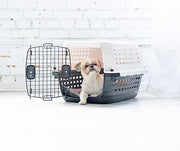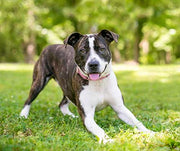How to Travel Safely With a Puppy

When your puppy is between 8 and 12 weeks old, she is in a key phase for socialization. This is a period during your puppy's development when it is especially important to get her out to discover the world. Car travel is most likely your means of travel with a puppy. While it is exciting for you to show your puppy to the world, traveling by car can be a daunting proposition for your puppy. Below are some tips to help you introduce your puppy to traveling safely in a car.
Neophobia
Between 8 and 12 weeks, and again at about six months of age, puppies experience what is called neophobia – or fear of new things. Keep this in mind as your begin exposing your puppy to new places. Be sure to always keep your puppy on a leash and provide comfort when needed. Traveling with your puppy can expose her to a wide range of positive experiences during this critical time. If you introduce your puppy to the bustle and hustle of daily living – busy streets, trains, cars – she will likely be more confident and comfortable around them in her adult life. And when your puppy encounters a new situation later in her development, she will be better prepared for it because of her travels in her puppyhood.
Introducing Your Puppy to a Car
Ideally, you will introduce your puppy to car travel as soon as you bring her home. In fact, we guarantee a car was involved at some point in bringing home your new puppy! To introduce your puppy gradually to a car, let her explore the car without the engine running. You can place a few treats on the seat where she'll be resting. When she seems at ease, be sure you restrain her using a puppy car seat or a dog seat belt. The next step is to start the car and take her for a slow, smooth drive around the neighborhood.
If your puppy is excessively pawing at the door, panting excessively, or whining your puppy may be uncomfortable in the car. If you see your puppy displaying these signs, return home and comfort your puppy with praise and a treat. Patience is key when getting your puppy used to being in a car. This can be a slow process, but your puppy will eventually get used to being in a car.
Once your puppy is comfortable in the car, increase the distance and length of time on the road. Be sure to positiviely reinforce her good behavior with lots of praise and treats!
Motion Sickness
It is common for puppies to get motion sickness when riding in cars. To help them maintain a positive association with car rides, try not to take your puppy in the car when she has a full stomach. To that end, be sure you give your puppy the chance to go to the bathroom before getting into the car. To keep your puppy as safe as possible during car rides, experts recommend putting your puppy in a plastic kennel, positioned on the floor in the back of the car to keep her safe and help prevent motion sickness.
Should I Let My Puppy Put Her Head Out the Window?
Let's face it, most dogs love riding in cars with their heads out the window. As fun and adorable as this is though, it's dangerous for your pet, and you as well! You should keep your puppy securely buckled at all times during a car rides to prevent distractions and/or injuries. While your puppy is young, it's best to keep windows rolled up. Sometimes, puppies do not have a danger indicator and will jump out an open car window! So, to be 100% safe, don't let your puppy stick it's head out the window.
Click here for more puppy training tips!
Additional Resources:
- https://www.petsthattravel.com/traveling-with-puppies-in-car/
- https://atraveltips.com/how-to-travel-in-a-car-with-a-dog/
- https://www.akc.org/expert-advice/home-living/dog-seat-belts-what-you-need-to-know-to-keep-your-dog-safe/
- https://www.akc.org/expert-advice/home-living/car-safety-for-dogs-training/
Previous article

Next article

Related posts
View all-

Holiday Gifts for Every Pet Personality: The Ultimate Guide
The holiday season is finally here, and for many of us, that means finding the perfect presents for the ones we love most—our pets. Whether they are a steadfast dog who never leaves your side or an independent cat who graces you with their presence on their own terms, our pets are cherished members of the family. They deserve to celebrate right alongside us, stocking stuffers and all.
Read Article -

How to Keep Your Pet Calm During Thanksgiving
Thanksgiving is a time for family, friends, and food, but for our pets, the holiday can be overwhelming. The sudden change in routine, unfamiliar faces and scents, and increased noise can trigger significant stress. Understanding why your pet might feel anxious is the first step toward creating a peaceful holiday experience for everyone, including your furry family members. This guide offers calming tips for pets and practical solutions to ensure your dog or cat feels safe and secure during the festivities.
Read Article -

Top Travel Essentials for Pets This Holiday Season
Holiday travel often means bringing the whole family along, and for many of us, that includes our furry companions. Preparing for holiday pet travel is about more than just packing a bag; it's about ensuring your pet's safety, comfort, and happiness from the moment you leave home until you return. A little planning helps reduce stress for both you and your pet, making the journey a positive experience for everyone involved.
Read Article



